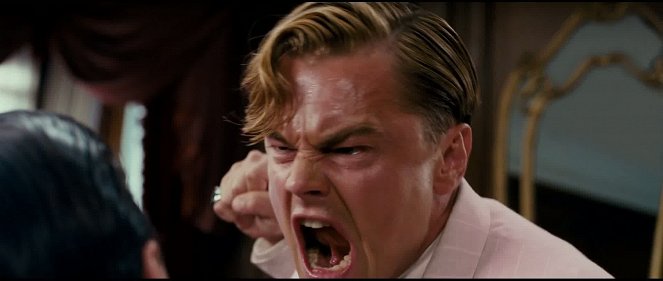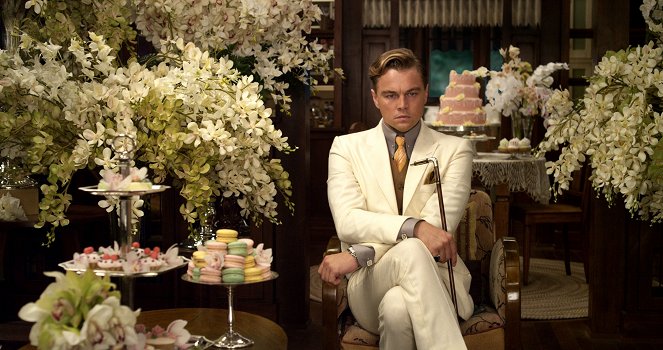Regie:
Baz LuhrmannKamera:
Simon DugganMusik:
Craig ArmstrongBesetzung:
Leonardo DiCaprio, Tobey Maguire, Carey Mulligan, Joel Edgerton, Isla Fisher, Jason Clarke, Elizabeth Debicki, Jack Thompson, Amitabh Bachchan (mehr)Streaming (4)
Inhalte(1)
New York, 1922. Der junge Broker Nick Carraway bezieht ein kleines Haus in Long Island inmitten all der Prachtvillen der Neureichen. Sein Nachbar, der geheimnisumwitterte Millionär Jay Gatsby, gibt auf seinem prunkvollen Anwesen ein rauschend ausschweifendes Fest nach dem anderen. Auf der anderen Seite der Bucht, lebt Nicks Cousine Daisy mit ihrem untreuen Mann Tom Buchanan. Als eingesessener Geldadel blicken sie auf die superreichen Emporkömmlinge verächtlich herab. Doch Daisy verbindet mit Gatsby ein tiefes Geheimnis, war sie doch die Liebe seines Lebens. (ORF)
(mehr)Videos (28)
Kritiken (15)
Der Zeitbogen von 1922/1929 (oder reicher, da die Rückblenden Gatsbys gesamtes Leben beleuchten) hat nicht enttäuscht. Das nenne ich einen Film, den ich auch mit dem Bauch wahrnehme. Ein formaler und dramatischer Orgasmus. Das Produktionsdesign ist perfekt (das ist nicht irgendein 20er-Jahre-Film, das sind genau die 20er-Jahre, für die ich lebe), und wenn Amitabh Bachchan auch noch tanzen würde, würde ich sechs geben. Der makellose Soundtrack lässt mich zu "Young and Beautiful" (Lana del Rey), "Love is Blindness" (Jack White) und dem Durchstarter "Bang Bang" (Will.i.am) im Takt wippen.
()
Ein theatralisch überexponiertes Liebesdreieck, dessen visuelle Seite unterhaltsam ist, der aber eine fade Seele hat. Luhrmann zieht Sachen heraus, die sich bei Moulin Rouge bewährt haben, aber von seiner Gefühlstiefe der tragischen Liebe ist er weit entfernt. Zu der Figur von Gatsby arbeitet man sich langsam durch, mit großen Erwartungen, und Leo sieht in den blassen Kostümen gut aus (wie jeder dort). Seine Figur entpuppt sich jedoch paradoxerweise als das widersprüchlichste Element mit der größten Entpersönlichung. Dem Publikum ist seine Figur egal, wobei die Geschichte gerade von seinem Lebenstraum handelt, der durch die schöne Daisy verkörpert wird. Mulligan ist nur eine Zierde, Edgerton als ihr harter Ehemann ist markanter als Leos Gatsby. Die einzige natürliche Figur ist hier der "Vertreter des Volkes“ Maguire. Moulin Rouge hatte Drive und war voller Leben – dank energischen oder emotional engagierten Songs. Der Große Gatsby kommt mit abgeleierten Schlagern von Jay-Z (die Identifikation mit New York) und mit dem bezaubernden Hit von Lana Del Rey versucht er dem Leporello von opulenten Bildern vergeblich eine romantische Dimension zu verleihen. So ein starker Stoff, so viele große Gedanken… Und die Augen der Zuschauerinnen bleiben trocken. ___ zum zweiten Mal: Die Szene der Konfrontation der Figuren im Hotelzimmer – wenn so psychologisch konzentriert und dramaturgisch sensibel der ganze Film wäre, d. h. ohne überflüssige formale Exzesse, und wenn er nur in den Schlüsselszenen zu Lana del Rey greifen würde, hätte das ein *außergewöhnlicher* Film werden können.
()
Was kann einen verrückter machen? Weil Fitzgerald laut Luhrmann ein oberflächlicher Manierist aus der zerrissenen roten Bibliothek ist? Dass die 1920er Jahre wie eine alltäglich anmutende industrielle Dystopie aussehen, gemischt mit der Extravaganz eines Lifestyle-Magazins? Oder weil die "Glamour"-Ästhetik des Films bis nur Nervigkeit ostentativ wirkt? Oder weil die Charaktere ausnahmslos flach wirken und der oberflächlichste zufälligerweise Erzähler ist? Oder weil der Film vollkommen unsinnig dramatisch aufgebaut ist? Oder dass von der Eleganz bzw. Dekadenz der Epoche "vor dem großen Fall" nichts mehr übriggeblieben ist als eine Sturmflut an Konfetti und digitaler Sterilität? Ich weiß es eigentlich gar nicht und es war mir auch nach einigen Minuten wirklich egal. Eine verdummende Erfahrung, welche Rex Reeds Worten am besten beschreiben: "Dies ist eines der zum verrücktwerdendsten Beispiele an Geldverschwendung, das jemals auf den Bildschirm gemüllt wurde."
()
It starts as intoxicating kitsch, then it becomes a tiresome mess stumbling on both feet. As far as gimmicky camera tricks and image wizardry go, Luhrmann is confident, but he fails in simple meaningful storytelling and in trying to get under the skin of the characters. I've mentioned kitsch – all those lavish parties make you feel like you're looking at a big garden dwarf, festooned with colourful ribbons and flashing light bulbs. But when it comes to feelings, it's like a shallow story in a girlie magazine, kind of plucking the daisy "He likes you, he likes you not, he likes you, he likes you not, he'll leave with you, he won't leave with you.....". Thank goodness for at least two things: Edgerton's manly Buchanan, the only full-blooded character in the entire panopticon, and the reunion scene between Gatsby and Daisy – the only moment in the entire film where you can feel any emotion. Luhrmann is getting a little stale.
()
The more problematic the film, the more you expect a standard adaptation of a classic book. The world of New York high society simultaneously disgusts and attracts Nick. He is aware of his ambivalent position as a person both on the inside and on the outside, a person who simultaneously wants and doesn’t want to be part of the story being told, and he is not only able to reflect that position, but he has to reflect it in his own interest. The narrator’s deeply personal relationship to “his” story and to the characters is emphasised by the fact that for Nick, retrospectively reconstructing who Gatsby actually was is a form of psychotherapy (similarly to the way that the search for the meaning of the word “rosebud” was an attempt to find the truth in Citizen Kane). Given the obvious hints that Nick is Fitzgerald’s alter-ego, writing (or rather retelling) as a form of therapy becomes one of the key motifs of the film. Also, the storyline involving the relationship between Nick and Gatsby (which strikingly lends itself to a queer reading) is ultimately the most authentic aspect of the film and, together with the therapeutic level of the narrative, rationalises the film’s double ending. ___ Like the narrator, Luhrmann sympathises with the characters, yet he places them in the surreal Technicolor world of major studio films, thus turning them into mere abstract ideas. In this rendering, Gatsby is merely the essence of the American mentality (the tenacious, self-destructive effort to achieve a particular ideal) and DiCaprio plays him accordingly. ___ Highlighting the narrative framework in comparison with the book (in which Nick simply tells the story, and why and to whom he is telling it are not important) is not a gratuitous attempt to bring a bit of tabloid subtext into the story – it rhythmises the narrative (“stepping out” of the story occurs at regular intervals) and influences its style. At the beginning, Nick speaks rapidly, as he is fascinated by all of the new stimuli and feels the need to quickly express all of his impressions. The cuts are abrupt and unexpected, and the shots are so short that it is difficult to find one’s bearings in them (it almost seems that there is a separate shot for every sentence). The camera never stops moving and, more so than later in the film, Luhrmann uses lap dissolves to create the impression that one shot blends into the next. The images sparkle, dazzling us with intense colours and CGI effects. We later become aware of the significance of the Sirk-like excessive work with colours, when it becomes clear why Myrtle was characterised in red and Gatsby in blue, or why it is important to know what colour Gatsby’s car is. The soundtrack is just as boisterous as the visual component of the narrative. ___ The choice of songs is the most striking (or rather loudest) link between today and the period in which the narrative is set. The soundtrack’s producers succeeded in selecting songs that can be imagined as contemporary alternatives to the music that was popular in the Roaring Twenties, though there is again a certain exaggeration (the shot of a car full of black people is accompanied by gritty gangsta rap). With its genre diversity, the soundtrack serves as an effective way to map the changes in mood that the film undergoes. ___ The film settles into a calmer, more classic style only after Nick’s story stabilises and focuses on Jay Gatsby as a man who personifies the limits of the American desire for success. The shots are longer, the narrator’s vocabulary is more colourful (which is also connected to the fact that Nick starts typing instead of speaking) and the lighting of the scenes is more natural. Together with the slowing of the film’s pace, the primary sources of inspiration also change. Whereas the noisy and flamboyant first third takes inspiration from the musicals of Busby Berkeley (and, I would venture to say, from the extravagant French epic productions of Marcel L’Herbier and other poetic realists), the film gradually progresses through excursions into gangster, adventure and war movie to a combination of social drama (The Crowd) and melodrama. Due to the doubling of the romantic storyline, however, it is rather an ironic commentary on the genre of melodrama (a sign that Luhrmann was not entirely serious is the pool shot in the film’s climax, which makes reference to the opening minutes of one of Hollywood’s most biting satires). ___ Because of the lifeless characters and excessive care taken to ensure that viewers understand exactly what is happening in the story, The Great Gatsby is an emotionally apathetic and laughably simple film. However, it is not a nonconceptual patchwork for lovers of pretty, shiny objects and expensive champagne (of one particular brand), though it does at first deceptively seem to be just that, even more so than Luhrmann’s earlier attempts to make the past present. 80%
()
(weniger)
(mehr)



Werbung